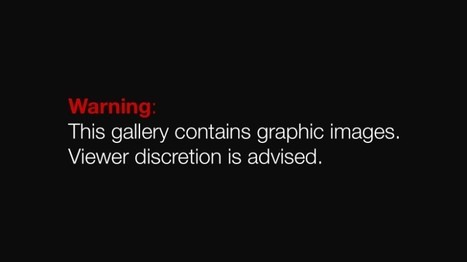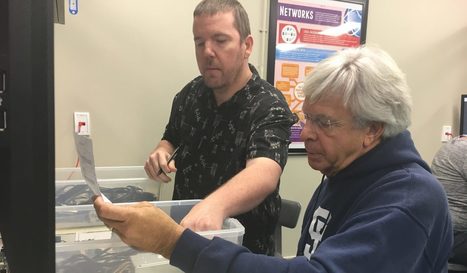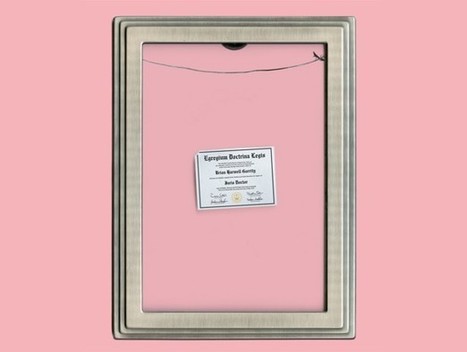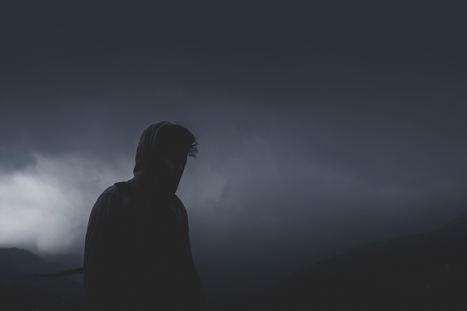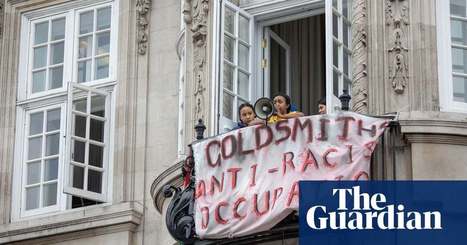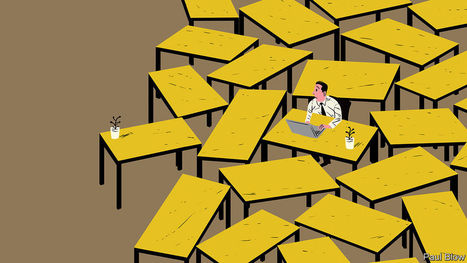 Your new post is loading...
 Your new post is loading...
Rutgers denies allegations of systemic racism at university Bridgewater Courier News Published 5:00 AM EDT Sep 8, 2020 Rutgers University frequently expresses solidarity with the Black Lives Matter movement, yet two Black employees who have filed civil rights lawsuits against the university have formed an alliance to combat what they call “systemic institution racism” at the university. At least four lawsuits have been filed by Black employees and former employees claiming racial discrimination and bullying. Rutgers has denied the allegations. Two of the plaintiffs – Lisa Scott, a former employer of the university’s human resources department on the New Brunswick campus, and Eleanor Bullock, a current employee of the university’s purchasing department – have formed End Inequality at Rutgers, an alliance of alumni, employees, and former employees. Together they have drafted a letter to Gov. Phil Murphy, university President Jonathan Holloway, legislators, civil rights leaders, celebrities and Democratic presidential candidate Joe Biden that describes a long history of racism at the university. “We believe that injunctive relief is extremely important in accomplishing the eradication of the cultural and racial discrimination, sexual harassment, harassment, and retaliation in the workplace at Rutgers University,” the letter states. “Systemic and institutional racism has proven again to be a horrible disease that is destroying our nation.” The letter asks for a meeting with Murphy and Holloway to discuss possible actions, including a survey of Black employees, a comprehensive evaluation of steps the university is taking to prevent workplace harassment, racial and cultural discrimination and an outside investigation into how on how the university’s Office of Employment handles employee complaints. Rutgers has maintained that it has a strict policy of not tolerating discrimination. "Rutgers University is committed to a working and learning environment for all faculty, staff, and students that is free from discrimination and harassment," Rutgers spokeswoman Dory Devlin said. "Discrimination against any member of our community — student, faculty, or staff — is not tolerated. The university takes all discrimination complaints seriously and follows a thorough, confidential, and fair complaint process required by university policies prohibiting discrimination. Any member of the university community who believes that he or she has been subject to conduct that violates the discrimination policy is encouraged to initiate a report. The Office of Employment Equity follows a rigorous complaint process outlined in the university’s Policy Prohibiting Discrimination and Harassment." 'Alarming trend' In her suit, Scott alleges sexual harassment and that the university and three executives excluded her from promotions and salary increases because of her race. Hired in 2009, Scott filed the sexual harassment complaint five years later against her supervisor, who has since died, claiming he masturbated in front of her while looking at pornography on his office computer. The suit also alleges she was the victim of his verbal abuse. The suit claims the university didn’t do anything to curtail his conduct. EARLIER: Ex-employee sues Rutgers over racial discrimination, retaliation While the supervisor was on leave from April 2016 to March 2017, Scott acted in his absence, but the suit alleges she “was not compensated for doing that work, unlike her white counterparts that were paid when they acted for another employee.” Her lawsuit also alleges she was the only employee at her level who did not have an office. The suit charges that a white male counterpart was immediately given an office when he transferred to the department. Scott also alleges the white male was paid more than her and received a bigger raise. Scott's job was eliminated last September in a reorganization of the registrar's office. In response to the lawsuit, Rutgers said it investigated Scott’s charges and found they were “unsubstantiated.” The university also called the lawsuit “frivolous.” Rutgers' Old Queens is the university's oldest building and home to the office of its president. ~File Still working for the university, Bullock alleges that after working in the university’s purchasing department for more than two decades, she was denied promotions because she is Black and was born in Belize, according to the lawsuit. Bullock was hired as an assistant buyer for Rutgers’ procurement services in 1998, according to the complaint, and was promoted to a buyer position five years later. Bullock also earned two master’s degrees from Rutgers, in 2008 and 2009, while she was employed. Despite her increased responsibilities and degrees, she has not been promoted since the early 2000s, according to the complaint. Bullock applied for several senior jobs in the department, as well as positions in different departments, but “was consistently turned down,” according to the complaint, and instead the university hired white employees. EARLIER: Rutgers employee sues, alleging she was passed over for promotion because of her race Rutgers has also denied the charges and said, in its defense that Bullock “failed to follow the relevant reporting procedures.” Both Scott and Bullock are represented by attorney Yvette Sterling. Bullock’s case is in mediation, while mediation in Scott’s case has been unsuccessful, according to court documents. Others who have filed discrimination lawsuits against the university include Chantel Harris and Teresa Macklin, former employees of the Paul Robeson Library on the Camden campus who allege that two supervisors created “an extremely hostile workplace,” including “racially offensive comments.” According to her lawsuit, Harris was accused of bringing a gun to work, but a police search proved the accusation false. The police search is part of her complaint, according to court documents. Rutgers has filed a motion in Superior Court to dismiss the lawsuit because Harris has not complied with a request to have an independent medical exam. A decision on the motion will be made Sept. 25. Macklin settled her case last year, according to her Red Bank-based attorney Loryn Lawson, who is also representing Harris. “It is unfortunate that our state university has such pervasive, ongoing racial discriminatory climate for many of its employees. An institution that prides itself as being at the forefront with the goal of diversity on its campuses, rather than have this same standard for its employees, Rutgers has a substantially lower standard for its working environment,” Lawson said. The university needs to take additional steps, the attorney said. “More is required than naming buildings after African Americans, such as the Paul Robeson Library,” Lawson said. “Now is the time when collectively our state residents demand more.” ‘Bunch of little kingdoms’ Lucye Millerand, executive vice president of URA-AFT, the university’s union for office workers, said Rutgers has a long history of bullying that has become systemic, Millerand said. “Bullying, whether racially based or not, is acceptable at Rutgers,” Millerand said. “Strong anti-bullying measures could help us all. Rutgers allows a tremendous amount of leeway to people with the power to behave in ways that shouldn’t fly. Even in much of corporate America, it doesn’t fly. The problem is that everything employment-related to staff is really discretionary. That’s one of the things that differs from the state or even a school district. Our (staff) people don’t have tenure. Anybody can suffer what Lisa Scott suffered, get cut out of their whole department.” Both Lawson and Millerand said that believe the Black Lives Matter movement could have an impact on systemic racism throughout the nation. “The push for racial justice right now will help validate and give courage to people who have faced discrimination and bullying,” Millerand said. “Maybe it will change the climate in our courtrooms and in terms of white folks being able to understand when people of color talk about their experiences and things that are hard to qualify. “We have to do better,” she continued. “There has to be more accountability at all levels of employment because it’s the Holy Roman Empire. It’s a bunch of little kingdoms at Rutgers; too many people who think they are little kings. Not all of them are acting out of racial inequality, but when they do, there’s nothing to stop them. It’s really important that employees of color are speaking up now.” Email: bmakin@gannettnj.com Bob Makin covers Rutgers for MyCentralJersey.com and the USA TODAY NETWORK New Jersey. To get unlimited access to his informative and entertaining work, please subscribe or activate your digital account today. Published 5:00 AM EDT Sep 8, 2020
A black man and a young Chinese woman are flirting, as he leans in for a kiss she thrusts a detergent capsule in his mouth and bundles him into a laundry machine.
Via Seth Dixon
Dr. Malinda Smith is visiting the St. John’s campus of Memorial to discuss the complexities, nuance and richness of Black scholarship across Canada and including Newfoundland and Labrador. Dr.Smith, professor, Department of Political Science and provost fellow, equity, diversity and inclusion policy...
A new report offers hard evidence for what you already suspected: MSNBC is riding hard against Bernie.
There are two types of bias at play in the media, and both contribute to unfairness: Bias in tone, and bias in volume. For example, an op-ed attacking Beto O’Rourke’s use of a Latino nickname is…
No amount of evidence will ever be enough to hold racist police officers to account when they terrorise and brutalise Roma communities.
To tackle institutional and systemic racism, we have to be aware of every part of the system, including the silence of implicit bias that blinds us to the larger system and what needs to be disrupted and dismantled More…...
Letters: Prof Yasmin Alibhai-Brown et al urge the mainstream political parties to acknowledge and confront all forms of racism, Liam O’Keefe says we must resist anti-Muslim behaviour so as to avoid the mistakes of the past and Gillian Dalley on nativist ideology...
Johnson & Johnson says its Baby Powder is safe. But Reuters found its talc was sometimes tainted with asbestos, a fact it kept from regulators and the public.
The same research found that nearly 75% of those transformations fail to improve business performance, either short-term or long-term. So why is transformation so difficult to achieve? Among many potential explanations, one that gets very little attention may be the most fundamental: the invisible fears and insecurities that keep us locked into behaviors even when we know rationally that they don’t serve us well.
Via The Learning Factor
On Wednesday, Mar. 21, Jackson Sasser, president of Santa Fe College, visited six classes and became “Student for a Day.”
For-profit law schools are a capitalist dream of privatized profits and socialized losses. But for their debt-saddled, no-job-prospect graduates, they can be a nightmare.
Higher-education institutions are overspending on renovations and new facilities that they hope will boost enrollment, but experts say this plan could lead to financial crisis.
Via Marc Wachtfogel, Ph.D.
|
"Craft beer is white. Whiter than a ski lodge. Whiter than a Whole Foods in the suburbs. Craft beer is so white, in fact, that there’s an entry for 'microbreweries' in Stuff White People Like, a book based on a blog written by a white person making fun of white people for being white. The passage concludes with this sentence: '[M]ost white people want to open a microbrewery at some point.' So, in the absence of statistics, I set out to answer a simple question: where the hell are all the black craft brewers, bar owners, bloggers, aficionados, and nerds? Why is craft beer -- the consumer side, and especially the business side -- so white?"
Via Seth Dixon
British society remains rigged against BAME people.
Every candidate who has come from outside the Democratic establishment has been smeared, dismissed or ignored by most media.
Let's be clear: One reason mainstream journalists were so wrong about the 2016 election is because they are largely divorced from poor and working-class voters.. After having been a mainstream TV news pundit, I’m unfortunately addicted to cable news (mostly MSNBC and CNN) and all the blather and repetition—laughably overhyped as "breaking news." Even when it's the same news that’s been breaking... and breaking... for hours or days.But I'm more bothered by the repetition of pundits and the narrowness of discussion, resulting in a number of unexamined clichés. Although the Democratic race for president has barely launched, mainstream media bias is already in orbit.
A recently published BMC Medicine article investigates the inherent inequality in the mental health service care received by patients from minority ethnic groups. Here, Dr. Kamaldeep Bhui discusses his team's findings.
Clique aqui para Português This is the fourth and final article in a four-part series highlighting research that demonstrates the unequal geographic distribution of violence against women in the context of pre-Olympic evictions in the city of Rio de Janeiro. Non-belonging, that is, the severing of bonds of attachment between a population and its territory, is an instrument of control that has historically been used as a tactic to advance processes of eviction or dispossession. Since the colonization of Brazil, the occupation, demarcation, and affirmation of physical and geographical control over space have formed the foundation of a set of deliberately unequal social and spatial relations. This dynamic of territorial fragmentation, the obstruction of access, and the expansion of settlements is characteristic of colonial-style occupation and is echoed in the contemporary production of urban space. As such, beyond clearly signaling the advance of real estate speculation and the market-based logic underlying the production of urban space, the Minha Casa Minha Vida (MCMV) federal public housing program—an heir to colonial urbanism—can also be interpreted as a tool of necropolitics. Necropolitics can be defined as the power to take away life held by the government, to the extent that individuals become superfluous and the workforce expendable for the reproduction of capital. Taking away life doesn’t only mean the act of killing, but also letting people die in neglecting to provide the infrastructure that sustains life and exposing people to the risk of death, such as through exposure to violence and insecurity. In this context, the dimension of race is fundamental to understanding how this mechanism operates: in deciding who should live and who should die, the government defines internal enemies based on invariably racist criteria. This is evident in the logic of MCMV in terms of the locations of housing developments, forgoing any possibility of promoting the right to the city. Through a municipal decree, the City of Rio de Janeiro defined Planning Area 5 (AP5), located in the far west of the city (two hours by transit from the city center), as a priority for the implementation of MCMV developments. Of MCMV’s 96 housing complexes, 49% were built in Planning Area 5. Of these, 53% are intended for families within the income bracket eligible for Social Interest Housing. Discussions on institutional racism—state racism—challenge interpretations of racial inequalities as the result of individual actions, demonstrating that there are mechanisms of structural discrimination that operate through public policies. What is suggested here is the possibility of similar parameters in force, a mechanism of gender discrimination that is a structural part of the hegemonic power and serves to maintain the status quo: institutional sexism. The City of Rio de Janeiro, through MCMV, implemented 37 Social Interest Housing developments. Of these, 73% were constructed in areas with high rates of violence against women in absolute numbers and that are among the Integrated Public Security Districts (CISPs) with the highest rates of violence per 10,000 women (according to data from the year 2010). Of the 30,211 Social Interest Housing units built since 2009, 77% are located in the 32nd CISP, composed of the neighborhoods of Anil, City of God, Curicica, Jardim Azul, Jacarepaguá, and Taquara; in the 35th CISP, composed of the neighborhoods of Campo Grande, Cosmos, Inhoaíba, Santíssimo, and Senador Vasconcelos; and in the 36th CISP, composed of the neighborhoods of Paciência and Santa Cruz, as shown in Table 1. Table 1: Minha Casa Minha Vida housing complexes built in each Integrated Public Security District (CISP). Table created by the author. CISP No. of Developments No. of Housing Units Percentage 6 1 990 3.28% 17 1 496 1.64% 21 1 200 0.66% 31 1 240 0.79% 32 4 4,620 15.29% 34 1 1,182 3.92% 35 10 3,967 13.13% 36 13 14,216 47.06% 39 2 1,820 6.02% 40 1 2,240 7.42% 44 2 240 0.79% TOTAL 37 30,211 100% Of the instances of rape that took place in 2016 in Rio de Janeiro’s West Zone (where a woman was raped every 13 hours), 48% took place in the areas where the most MCMV housing complexes were built—namely, in the 32nd, 35th, and 36th CISPs. The process of urban segregation and the peripheralization of housing affects women more acutely—not only because of the lack of basic urban infrastructure and essential services, like daycare centers, schools, hospitals, and transportation, but also because of domestic and urban violence. Distance relative to former place of residence is another important factor because displacement to excessively distant locations can break ties of solidarity and mutual support, which, for women—who are responsible for reproductive labor and caring for dependents—are essential in order to maintain work relations and individual autonomy. The notion of the “right to the city” is central to the contemporary critique of inequality of access to urban infrastructure, but as a general rule, it is a criticism irrespective of gender, race, or class. In this sense, what is the paradigm for realizing the “right to the city” for women? Obtaining housing is indispensable to the exercise of citizenship. The effectiveness of housing policy, however, cannot be reduced to the construction of four walls and a roof. It requires a broader view of reality, including issues such as education, health, work, and income generation. In 2016, approximately three women were raped each day, a woman was killed every three days, and nine women were physically abused every five hours in the city of Rio de Janeiro. It is not a question of denying the importance of large-scale housing production for the low-income population and the potential progress that MCMV represents given the resources invested in Social Interest Housing, but rather a question of highlighting another factor that solidifies criticisms concerning the logic of the program’s locations, specifically in Rio de Janeiro. Finally, it is important to highlight that in the West Zone—the same region with alarming rates of violence against women—strong feminist collectives exist and resist. In the struggle against evictions, new challenges and threats demand political organization and the strengthening of strategies and discourse. “Women,” as a collective subject, have established a new political ethic based on care and daily relationships, solidifying a strategy to combat the constant attempts to strip away rights. Thus, constructing new meanings and building the city every day in communities facing eviction like Barrinha, Araçatiba, Rio das Pedras, Vargem Grande, and in Vila Autódromo, women keep fighting. Complete Series: Violence Against Women in the Context of Rio’s Pre-Olympic Evictions Part 1: Introduction Part 2: Violence as a Policy of Control Part 3: Domestic Violence and Femicide Part 4: Institutional Sexism in a Patriarchal City
Campaigners say university failed to respond adequately to racist abuse of student elections candidate...
The Salesforce Tower: A Blight On The San Francisco Skyline - J.Thomas/BlackHorseMedia
I can’t get myself to take a photo of this obviously phallic edifice, although it intrudes on the eye from almost everywhere in the City. So I’ve substituted a stock photo of an industrial air-conditioner (thanks Alex Mak/Broke-Ass Stewart). Can you really tell the difference? I think not….. One of the worst decisions in the history of city planning, urban design, and simple esthetics was made during the administration of Mayor Diane Feinstein. She removed the height limits on new buildings downtown, and actively promoted the “Manhattanization” of the San Francisco skyline. Since the go-go 80’s, scores of hideous structures have blotted out the sky, created wind tunnels, and inflated real-estate values. No one structure embodies all three more so than the Salesforce Tower. The City and County of San Francisco cannot figure out how to get public restrooms or housing built, and yet somehow a monument to greed, a veritable Tower of Babel was allowed to spring up almost overnight. This hideous apparition is supposed to symbolize “tech,” but in fact it is the essence of everything that is wrong with the technology sector. Instead of improving life for the average person, tech has dedicated itself to making the wealthy even wealthier, mostly by selling things with no intrinsic value. "Tech" has exploited peoples desire to be liked by charging them a fortune for "services" like "airtime" and "data." It has even figured a way to charge you to watch advertisements. The Wikipedia entry says: “Salesforce is the primary enterprise offering within the Salesforce platform. It provides companies with an interface for case management and task management, and a system for automatically routing and escalating important events. The Salesforce customer portal provides customers the ability to track their own cases, includes a social networking plug-in that enables the user to join the conversation about their company on social networking websites, provides analytical tools and other services including email alert, Google search, and access to customers' entitlement and contracts.[17]” This type of hyper-specialization and monetization of every single detail can only add to the cost of whatever product is being sold. If it’s Teslas, it really doesn’t matter. But if it’s consumer goods, it means YOU have to pay Salesforce for something of absolutely no value to you. But that is the essence of tech these days. Innovation? What’s innovative about email? The “cloud” is where information has always lived. Lot’s of fancy terms to make things seem more complicated than they are. And charge for them. What is Uber but a "gypsy" taxi service that has managed to “disrupt” the incomes of people who have worked their entire lives to pay for a medallion? There’s a hundred apps that deliver food; something Chinese restaurants have been doing for 100 years. I confess to being an Amazon Prime member (special circumstances, heh-heh), but I was fine with UPS. Technology is supposed to make everyone's lives easier and better. So far the only real progress towards this end has been in renewable energy. But not nearly enough; burning filthy fossil fuels is still how the “industrialized nations” get most of their electricity, as well as to charge up their non-essential personal vanity-mobiles. And bio-tech seems to be devoting all it’s energy in extending the lives of few wealthy white people. Cure cancer? It is to laugh! They haven’t even figured out how to cure the common cold. The Salesforce Tower uses more electricity than the City of El Cerrito. Well, maybe not, but where’s the “tech” in the energy use? A building this size should capture all the water it needs from rainfall and fog-drip, recycle and compost all of it’s own waste, and generate at least half of the electricity it needs. But I’m afraid it’s just another airless box to join the Millennium Tower, Rincon Tower, et. al. These buildings all have one thing in common; fossil-fuel dependent, overpriced, completely out-of-scale for the City... and they are no place to raise a child.
Via ThePlanetaryArchives/BlackHorseMedia - San Francisco
Last fall I started my first day on the job as an embedded faculty member with a corporation—as a scholar-in-residence at Steelcase Education. Bu
I’m fed up with the inefficiency of the judicial system! I’m going to become a judge. I may not be a lawyer, but I’ve been a law-abiding citizen all my life, I mean, how hard could it be? I have 20...
Via Mary Perfitt-Nelson
If, like an ever-growing majority of people in the U.S., you own a smartphone, you might have the sense that apps in the age of the pocket-sized computer are designed to keep your attention as long as possible. You might not have the sense that they’re manipulating you one tap, swipe, or notification at a time.
But Tristan Harris thinks that’s just what’s happening to the billions of us who use social networks like Facebook, Instagram, Snapchat, and Twitter, and he’s on a mission to steer us toward potential solutions—or at least to get us to acknowledge that this manipulation is, in fact, going on.
Harris, formerly a product manager turned design ethicist at Google, runs a nonprofit called Time Well Spent, which focuses on the addictive nature of technology and how apps could be better designed; it pursues public advocacy and supports design standards that take into account what’s good for people’s lives, rather than just seeking to maximize screen time. He says he’s moving away from Time Well Spent these days (his new effort is as yet unnamed), trying to hold the tech industry accountable for the way it persuades us to spend as much time as possible online, with tactics ranging from Snapchat’s snapstreaks to auto-playing videos on sites like YouTube and Facebook.
“It’s so invisible what we’re doing to ourselves,” he says. “It’s like a public health crisis. It’s like cigarettes, except because we’re given so many benefits, people can’t actually see and admit the erosion of human thought that’s occurring at the same time.”
Via Wildcat2030
|




 Your new post is loading...
Your new post is loading...


